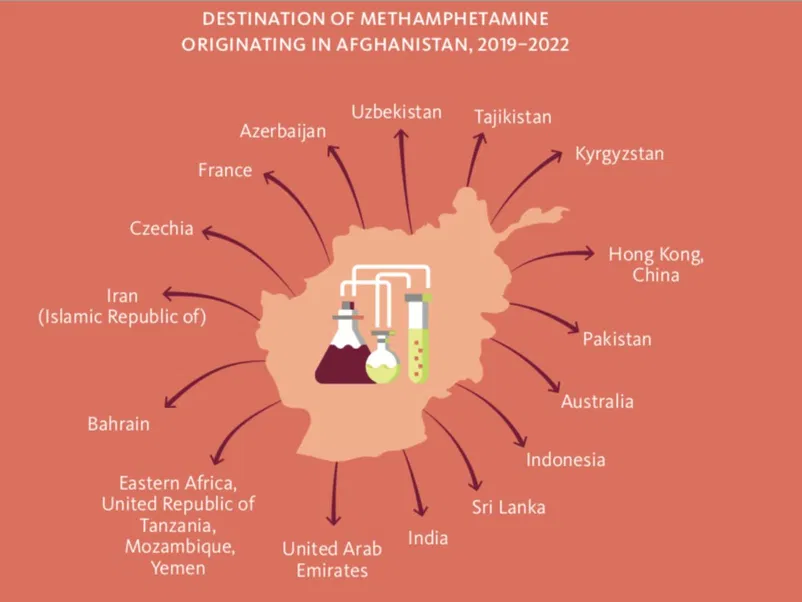The impact of the Taliban’s ban on opium cultivation and all the dope from the World Drug Report 2023.

In 2022, the illicit opium production in Afghanistan reached 6,200 tonnes
New Delhi: A year after the Taliban banned opium harvest in Afghanistan, illicit manufacture of methamphetamine is increasing in the war-torn country, reveals the World Drug Report 2023 launched by the UN Office on Drugs and Crime (UNODC) on June 26.
“The recently announced ban on narcotic production in Afghanistan may be changing the drug supply in that country. Continued reports and seizure events involving methamphetamine originating in Afghanistan suggest that the drug economy in that country is no longer exclusively dominated by illicit cultivation and trafficking of opiates. Questions remain regarding the linkages between illegal manufacture of heroin and of methamphetamine and whether the two markets will develop in parallel or whether one will substitute the other,” the Report said.
“Ongoing changes in Afghanistan are likely to have far-reaching effects on global drug markets, as the country (Afghanistan) has remained a key source of heroin for world markets for decades. Sharp disruptions in the supply of poppy and heroin could have severe effects for those who use drugs, as well as for impoverished farmers who have come to rely on the illegal opiate economy,” it warned.
In 2022, the illicit opium production in Afghanistan reached 6,200 tonnes, equivalent to 80% of the estimated global production (7,800 tonnes). Afghanistan was followed in volume by Myanmar (795 tonnes) and Mexico (504 tonnes).
Quoting the latest data available for 2019/2020, the WDR 2023 pointed out that although global opium poppy cultivation increased markedly in 2022, the drug ban in Afghanistan may reverse the trend for 2023.
“Although the global area under opium poppy cultivation increased by more than 26% from the previous year, primarily linked to increases reported from Afghanistan (32%) and Myanmar (33%), global opium production declined marginally (3%) over the same period. This was due to less opium being produced in Afghanistan (10% less) as a consequence of droughts in early 2022. The 2023 opium harvest in Afghanistan may see a drastic drop following the 2022 national drug ban, with possible global consequences,” the Report said.
“Time is needed to determine whether trends hold and the effect that may have on global heroin markets, especially those sourced by opium from Afghanistan,” it added.
Romesh Bhattacharji, former Narcotics Commissioner of India and founder of the think tank Institute of Narcotics Studies and Analysis (INSA): “I don’t believe at all that opium cultivation will reduce in Afghanistan. The produce goes mainly to Pakistan and the West. If at all, there indeed is reduction in Afghanistan, north-west Pakistan and Iran may witness increased cultivation.”
However, Bhattacharji denied the development may have any bearing on India, especially the illicit opium cultivation in the northeastern states. India has traditionally been used as a transit point for drug trafficking as it is situated between the Golden Crescent (comprising Iran, Afghanistan and Pakistan) and the Golden Triangle (located across Thailand, Myanmar and Laos), which are major opium producing regions in the world.
The spread of Meth
Global methamphetamine manufacture, trafficking and use remains concentrated in East and South-East Asia and North America, with the two sub-regions accounting for almost 90% of methamphetamine seized globally in the period 2017–2021, the report pointed out.
“Manufacture of methamphetamine is no longer restricted to the established markets, with the detection of clandestine methamphetamine laboratories in South West Asia, South Asia and Africa. There are increasing signs of large methamphetamine manufacture in Afghanistan and expanded trafficking through South Asia for markets in Oceania, Europe and elsewhere,” it warned.
Opioids leading cause of overdose deaths
Opioids remain the leading cause of deaths in fatal overdoses and accounted for nearly 70% of the 1,28,000 deaths attributed to drug use disorders in 2019, the Report said, adding, “Opioid use disorders also accounted for the majority, 71% of the 18 million, healthy years of life lost owing to premature death and disability in 2019.”
Also, opioids continue to be the main drug that impacts the global burden of disease whereas cannabis is reported by a large share of countries as the drug of most concern for drug use disorders. Opioids account for 38% of treatment for drug use disorders in 2021.
Opioid use disorders cost an estimated 12.9 million years of “healthy” life lost due to disability and premature death in 2019, equivalent to 71% of years of “healthy” life lost due to drug use disorders. The Report also pointed out how an estimated 39.5 million people worldwide were suffering from drug use disorders in 2021, but only 1 in 5 people with drug use disorders received drug treatment. “The Covid-19 pandemic has aggravated the treatment gap,” it noted.
Ghada Waly, Executive Director United Nations Office on Drugs and Crime, said in the preface to the report: “The harms caused by drug trafficking and illicit drug economies are contributing to and compounding many of these threats, from instability and violence to environmental devastation. Illicit drug markets continue to expand in terms of harm as well as scope, from the growing cocaine supply and drug sales on social media platforms to the relentless spread of synthetic drugs – cheap and easy to manufacture anywhere in the world, and in the case of fentanyl, deadly in the smallest of doses.”
Other salient findings of the report
· One in every 17 people (aged 15–64) in the world had used a drug in 2021.
Drug use continues to be high worldwide. In 2021, 1 in every 17 people aged 15–64 in the world had used a drug in the past 12 months. The estimated number of users grew from 240 million in 2011 to 296 million in 2021 (5.8% of the global population aged 15–64). This is a 23 per cent increase, partly due to population growth.
· Women account for 42% of cannabis users in North America.
Cannabis continues to be the most used drug, with an estimated 219 million users (4.3% of the global adult population) in 2021. Use of the drug is increasing and although globally cannabis users are mostly men (about 70%), the gender divide is reducing in some sub-regions; women account for 42% of cannabis users in North America.
. An estimated 36 million people had used amphetamines in 2021.
It is estimated that in 2021, 36 million people had used amphetamines, 22 million had used cocaine and 20 million had used “ecstasy”-type substances in the past year. The proportion of female users is higher in the case of amphetamine-type stimulants (45% of users are women) and non-medical use of pharmaceuticals (between 45 and 49% of users are women), whereas the highest share of men is found in users of opiates (75%) and cocaine (73%).
· An estimated 60 million people engaged in non-medical opioid use in 2021.
Opioids continue to be the group of substances with the highest contribution to severe drug-related harm, including fatal overdoses. An estimated 60 million people engaged in non-medical opioid use in 2021, 31.5 millions of whom used opiates (mainly heroin).
An estimated 13.2 million people were injecting drugs in 2021. This estimate is 18% higher than in 2020 (11.2 million). In absolute terms, North America now has the highest number of individuals who report injecting drugs, ahead of East and South-East Asia.
(This story first appeared on news9live.com on Jun 26, 2023 and can be read here.)



